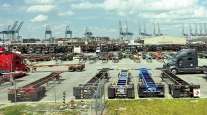Intermodal Traffic Drops in 2016, First Annual Drop Since 2009

After four consecutive years of record-breaking intermodal growth in the railroad industry, container and trailer traffic dropped 1.6% in 2016, according to data from the Association of American Railroads.
For the full year, railroads transported 13.5 million intermodal containers and trailer units, down from 13.7 million in 2015. Carload traffic dropped 8.2% to 13.1 million carloads in 2016, which includes the transportation of commodities such as coal, grain, chemicals, petroleum and construction materials.
“Last year was challenging for freight railroads,” said John Gray, AAR senior vice president of policy and economics. “Rail carloads were down for the second consecutive year, due mainly to a weak manufacturing economy and turmoil in energy markets, while intermodal failed to set its fourth straight annual record. That said, there are signs that the economy may be gradually returning to a period of growth.”
RELATED: Construction begins on New Jersey intermodal terminal
The final results are consistent with the latest data from the Intermodal Association of North America. It reported the amount of trailers, containers and other equipment loaded onto railcars dropped 4.6% to 4.3 million units in the third quarter of 2016 versus the same period in 2015. In the same period, domestic container traffic increased 3.3% to 1.9 million units and international containers fell 6.7% to 2.2 million.
“There’s never been two consecutive negative quarters except in an economic recession, but we are in a freight recession right now,” said Pat Casey, vice president of fleet management at TTX Co., in a November 2016 webinar on the IANA report.
Larry Gross, an intermodal and rail expert at consultancy firm FTR, agreed with Gray that the tide turned positive in the fourth quarter but that much of the year was difficult for the industry.
“The primary culprits would seem to be more East Coast import [containership] routings that are less intermodal-friendly, more transloading into domestic intermodal equipment and perhaps more truck competition,” Gross said.
At the bottom of the spot market in 2016, truckload rates were so low that it convinced some shippers to shift modes from rail to road to save money, but he said that current signs point toward a reversal in 2017.
“With demand strengthening, truck spot rates rising and overall truck capacity utilization tightening as [electronic logging device] implementation day approaches, I expect 2017 to be a considerably better year for intermodal than 2016.” Gross said.
The data also showed the intermodal sector posted stronger results in the fourth quarter as rail traffic volume, encompassing carloads and intermodal, jumped 3.5% year-over-year, Gross said. For December 2016, traffic was 1.99 million units, up 6.9% from December 2015, according to the Association of American Railroads.
“We anticipated stabilization and a modest [turning point] around midyear, and we got it by the fall, so we may be, except for coal, at an ‘all’s well that ends well’ situation,” said Anthony Hatch, a railroad industry analyst. “In 2017, we expect a slightly growing economy, tighter [normal] trucking, stable coal — and even good grain numbers.”
But another analyst urged caution to the railroads for 2017, even with the positive forecasts.
“While President-elect Trump’s election promises may boost certain sectors, such as coal, any gains may take a considerable amount of time to be realized,” said W. Scott Timpson, head of the global rail practice at Argo Consulting.
He added, “The prudent move for the freight carriers is to continue a focused effort on cost reduction. 2017 could prove to be another grind much like 2016. Volatility calls for further cost reduction.”




